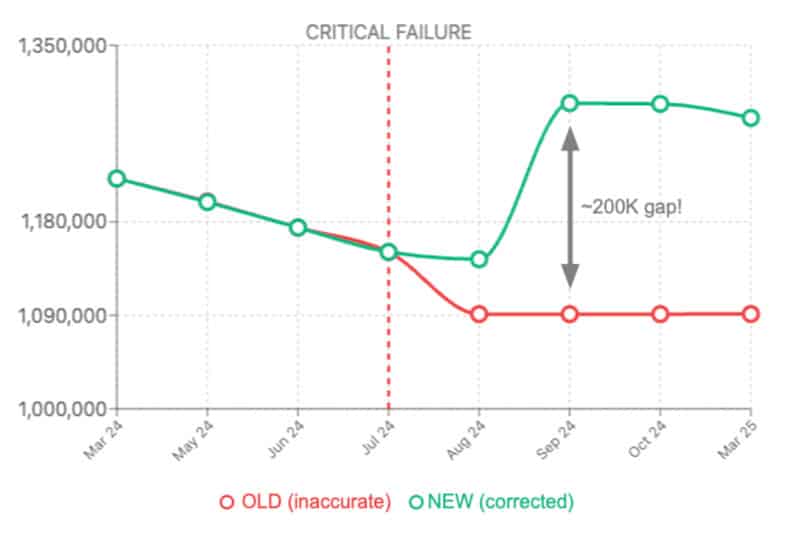US issues corrected student visa data showing growth for 2024 while current trends point to an enrolment decline for 2025/26
- The US Department of Homeland Security has just released corrected student data for 2024, effectively erasing a 200,000-student error and confirming that the US saw continued growth in foreign enrolment for 2024/25
- The latest visa issuance data from the Department of State, however, points to declining visa numbers through May 2025, a trend that is likely to be exacerbated by a nearly month-long pause in new visa appointments over May and June
In April 2025, we reported that foreign enrolments in the US had declined by -11% between March 2024 and March 2025. This was based in turn on analysis from sector experts in the United States, who relied on data from the Student and Exchange Visitor Information System (SEVIS).
It came to light soon after, however, that there were some significant errors in the US data. EnglishUSA discovered the issue in the course of some of its ongoing analysis of the SEVIS data and reported the discrepancy to the Department of Homeland Security (DHS) on 14 April.
DHS republished the corrected SEVIS data on 2 July, and it tells a very different story in terms of 2024 enrolment. But it also signals a more cautionary outlook for the coming academic year.
Correcting the record for 2024
Updated analysis from by Chris Glass – a professor and higher education specialist at Boston College and an affiliated faculty member at the Center for International Higher Education (CIHE) – highlights that there is a 200,000-student difference between the earlier, incorrect SEVIS data and the corrected numbers published this month.

"The gap first appears in August and undercounts the number of international students. The gap widens by September: 1,294,231 (new/corrected) vs 1,091,182 (old/inaccurate) = 203,049 undercount," says Professor Glass. "Nine months passed between the problem's start in August and the takedown in April. It's still unclear whether anyone at DHS noticed the issues before that mid-April alert [from EnglishUSA]."
The bottom line from that correction is that – rather than an -11% decline between March 2024 and March 2025 – foreign enrolment in the US actually grew by 6.5%. This contributes to overall growth for the US of 26% over the past five years to reach an historic high of 1,294,231 students as of September 2024.
The outlook for the coming academic year
While the corrected SEVIS data tells a much more positive story for 2024/25, there are some indications that student numbers will under considerably more pressure for the 2025/26 academic year.
In particular, the non-immigrant visa data through May 2025 tells the story of declining F-1 visa issuances through the first half of this year.
Those Department of State figures indicate that the number of F-1 visas issued dropped by more than -14% for the period January–May 2025 (compared to the same period the year before).
"The data through May already looked bad for fall enrolment," adds Professor Glass. "Then came the pause in visa appointment scheduling during peak processing season." That three-week+ pause in new visa appointments occurred during the key May to August period in which the lion's share of F-1 visas are typically issued each year.
"Now that appointments have resumed, the backlog—plus expanded social media screening for all F, M, and J visa applicants—has slowed everything down," he adds. "The math is simple: fewer visa appointments plus slower processing equals fewer students."
We won't know the true scale of that impact until later this year, but Professor Glass has projected that the processing pause, in combination with the now-expanded vetting requirements, could lead to between 80,000 and 145,000 fewer visa appointments from June through August, compared to the same period last year. "This translates into a potential international student enrolment drop of -7–11% this fall," he says.
In a related development, a June 2025 sector analysis from Moody's warns of the heightened financial risk for US universities arising from a decline in foreign enrolment. "Evolving visa policies and deportations are diminishing the perception of the US as a prime destination for higher education," says the ratings agency. "These policies will have the most effect on universities with a higher reliance on international students overall, including those with graduate and specialty programmes."
"The largest revenue impact will be among the 15% of our rated universities with over 15% international students, some of which have over 30%. However, the credit impact will be most pronounced among entities even with lower exposures that are already in fiscal stress with weak liquidity."
For additional background, please see:
















